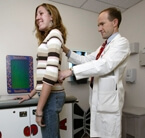
Already widely used in children with severe idiopathic scoliosis, a surgical approach using growing rods to stabilize the spine now appears to be safe and effective in another subset of scoliosis patients — those with spinal muscular atrophy (SMA), according to a study led by Johns Hopkins Children’s Center investigators. Scoliosis develops early and progresses quickly in nearly all infants and children with moderate to severe forms SMA. Bracing, which is often the first treatment choice in scoliosis, does not appear effective in halting progression of spinal curvature in SMA patients. Another common approach — spinal fusion surgery — when done at an early age may limit trunk growth and worsen preexisting pulmonary problems, which afflict nearly all SMA patients.
The researchers analyzed outcomes from 15 SMA patients with severe scoliosis — defined as spinal curvature of more than 70 degrees — treated with this technique and compared the results with outcomes among 80 idiopathic scoliosis patients treated the same way. The team’s findings are reported in a recent issue of the journal Spine.
Growing rods improved trunk height while also curbing curvature progression and pelvic misalignment (obliquity) in both in SMA patients with severe scoliosis and in those with idiopathic forms of the condition. On average, spinal curvature in SMA patients improved by more than one-third (34 degrees), pelvic misalignment was reduced by an average of 20 degrees, and thoracic and lumbar length grew by an average of nearly 9 centimeters. And, importantly for SMA patients with pulmonary problems, the space-lung ratio also increased somewhat even as the spine was strengthened, the researchers found.
While the technique successfully halted rib collapse in the idiopathic group, it didn’t do so in the SMA group. SMA patients also had somewhat longer hospital stays than non-SMA scoliosis patients. However, the rate of serious postoperative complications was lower in the SMA group compared with the idiopathic group.
“This is encouraging news for a group of scoliosis patients who traditionally have had very few, if any, treatment options. This approach can lead to good outcomes with few complications,” said senior investigator Paul Sponseller, M.D., director of Pediatric Orthopedic Surgery at Hopkins Children’s.
